Horseback camping, otherwise known as equine camping is the act of camping with your horse. This can be done at horse-friendly campgrounds or it can be done along horse-friendly hiking trails. Some people also engage in horseback camping on private land.
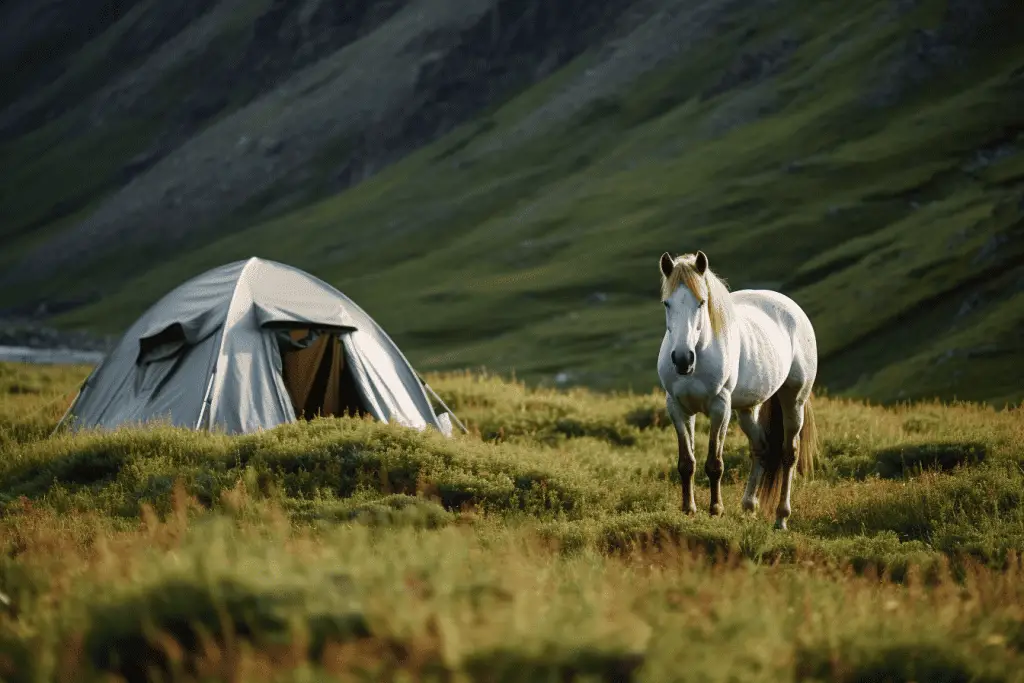
Why Go Horseback Camping?
So, you’re curious about horseback camping? Let me tell you, it’s the perfect blend of two amazing worlds: camping and horseback riding. Imagine riding through the wilderness during the day, then settling down next to a campfire at night with your equine buddy right there with you. It’s the ultimate way to connect with nature and deepen your bond with your horse. A traditional camping trip can be fun, but adding the element of horseback riding kicks the adventure up a notch.
Now, let’s talk about the sense of freedom and exploration that comes with horseback camping. Sure, hiking can get you to some pretty cool spots, but covering ground on horseback allows you to see more and go farther. You’re not limited by the weight of a backpack or the pace of your two-legged stride. With a horse, you can venture deeper into the wilderness and discover spots that are less accessible to the average camper or hiker.
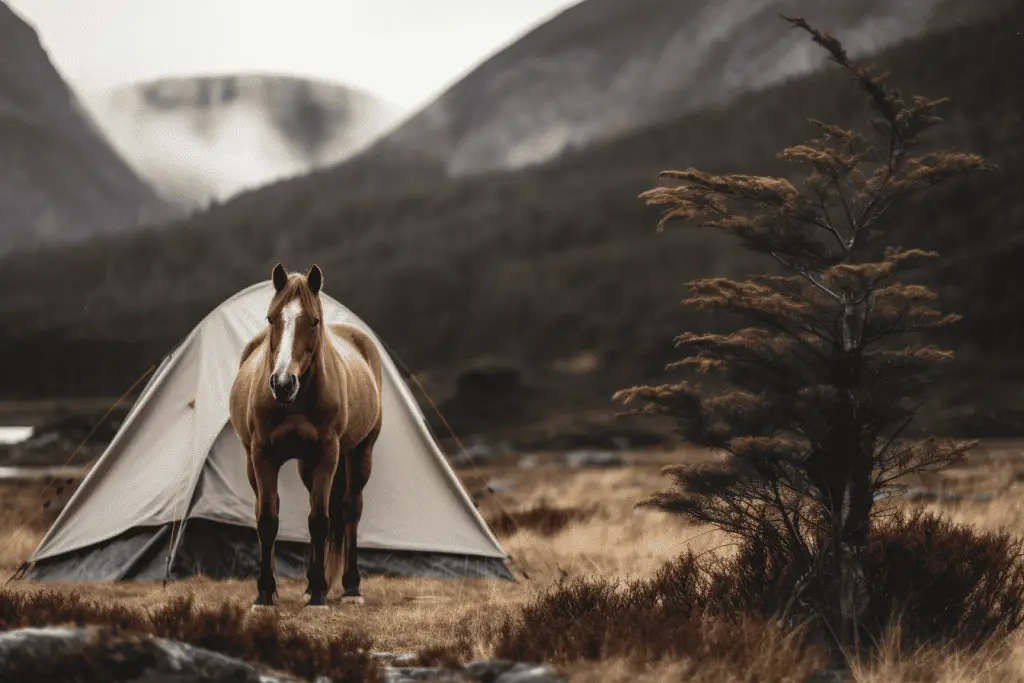
Health benefits, you ask? Horseback camping delivers on that front too! Like traditional camping, it gets you out in the fresh air, exercising both body and mind. You’re not just setting up a tent; you’re also taking care of your horse, which requires a good deal of physical work. Mentally, the combined tasks of riding and camping keep you engaged and help reduce stress. Plus, let’s not forget the complete full-body workout you get from riding itself.
Last but not least, horseback camping is a fantastic way to build a community. Not only do you get to share the experience with your horse, but you also have the opportunity to meet like-minded individuals who share your love for adventure and animals. Whether you join a guided expedition or plan a solo journey, you’re bound to make some lasting memories and potentially some new friends. So, why not give it a try? Trust me, it’s an experience you won’t soon forget.
Still not sure if you should go horseback camping? Here is a quick list of the pros and cons of equine camping.
| Pros | Cons |
|---|---|
| Deepens bond with your horse | Requires specialized gear |
| Allows greater exploration | Time-consuming preparation |
| Full-body workout | Potential for injury to rider or horse |
| Access to less crowded, more remote areas | Requires expertise in both riding & camping |
| Opportunity to meet like-minded individuals | Limited to horse-friendly locations |
| Reduces stress through outdoor exposure | Requires additional planning for horse care |
| Enhances riding and camping skills | Weather-dependent |
| Creates lasting memories | Might encounter wildlife hazards |
| Encourages responsible outdoor ethics | Requires knowledge of Leave No Trace principles |
| Immersive nature experience | Some terrain may be too challenging for beginners |
Where To Go Equine Camping: Campgrounds, Trails, or Private Lands
When it comes to horseback camping, one size definitely doesn’t fit all. Whether you’re a seasoned camper looking to bring your horse into the mix, or an equestrian craving a more adventurous outing, there are various options to consider. From the well-equipped equine campgrounds to the rugged allure of wilderness trails, and even the tailored experience of private lands, each offers its own set of advantages and challenges. Buckle up and let’s delve into these three unique horseback camping experiences to help you decide which one might be your perfect fit.
Equine Camping Campgrounds
Campgrounds designed for horseback riders typically offer amenities like corrals, water sources, and designated trails. This means you can focus more on enjoying your adventure and less on logistics. You’ve got a spot to safely keep your horse and likely some helpful staff or fellow campers around if you have any questions.
Now, let’s talk about amenities. You’re out in nature, but that doesn’t mean you have to completely rough it. Many horse-friendly campgrounds have restrooms, showers, and sometimes even small shops where you can buy supplies or snacks. So, while you and your horse are getting that authentic outdoor experience, you still have some of the comforts of home at your fingertips.
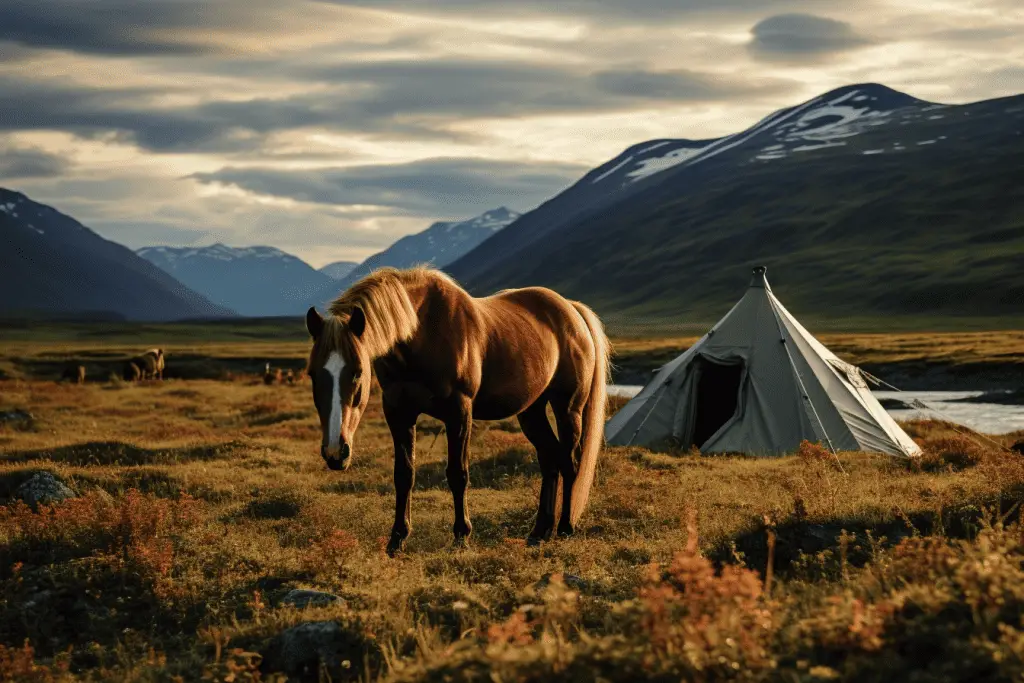
Safety is another big plus. These campgrounds are generally well-maintained and supervised, providing a secure environment for both you and your horse. Plus, with marked trails and maps available, you’re less likely to get lost or wander into unsafe territory. And if you’re new to horseback camping, what better way to dip your toes in the water? You’ll have experienced riders and campground staff nearby to offer tips or lend a helping hand.
Last but not least, horse-friendly campgrounds often foster a sense of community. You’re surrounded by fellow equestrian enthusiasts, making it easy to swap stories, share advice, or even make new riding buddies. All in all, it’s a win-win situation for you and your horse.
Pros and Cons of Horseback Camping at Campgrounds
| Pros | Cons |
|---|---|
| Access to amenities (restrooms, water, etc.) | May be crowded |
| Designated, secure areas for your horse | Might lack the “wilderness” experience |
| Likely to have well-marked trails | Cost involved |
| Community of like-minded individuals | Limited to the amenities and rules of the campground |
| Increased safety due to staff and regulations | May require advance booking |
| Great for beginners | Not as adventurous as backcountry camping |
Personal Thoughts on Equine Campgrounds
Equine campgrounds are a game-changer. I’ve had my fair share of horseback camping trips, and the amenities these places offer make a world of difference. Having a designated corral for my horse means I can relax without constantly worrying about her. Plus, the well-marked trails give me a chance to explore without the stress of getting lost. What I also love is the sense of community. You meet fellow riders who share your passion, and there’s always someone around to lend a hand or offer some advice. If you’re new to horseback camping, or just want a more convenient outing, these campgrounds are the way to go.
Equine Wilderness Camping
Ah, the allure of camping along trails with your horse—it’s the essence of adventure! When you opt for trail camping, you’re fully embracing the wilderness experience. It’s just you, your horse, and the great outdoors. You get to decide where you’ll stop for the night, and the sense of freedom is unparalleled. This is your chance to escape the crowds and experience solitude in a way that a campground just can’t offer.
But let’s get real for a second; this isn’t an endeavor for the faint-hearted. Camping along trails means you’re your own boss, but it also means you’re your own cook, guide, and even vet for your horse. There are no marked corrals or convenient water taps. You’ll need to be prepared, carrying all the essentials for both you and your horse, and have a solid grasp on wilderness survival basics.
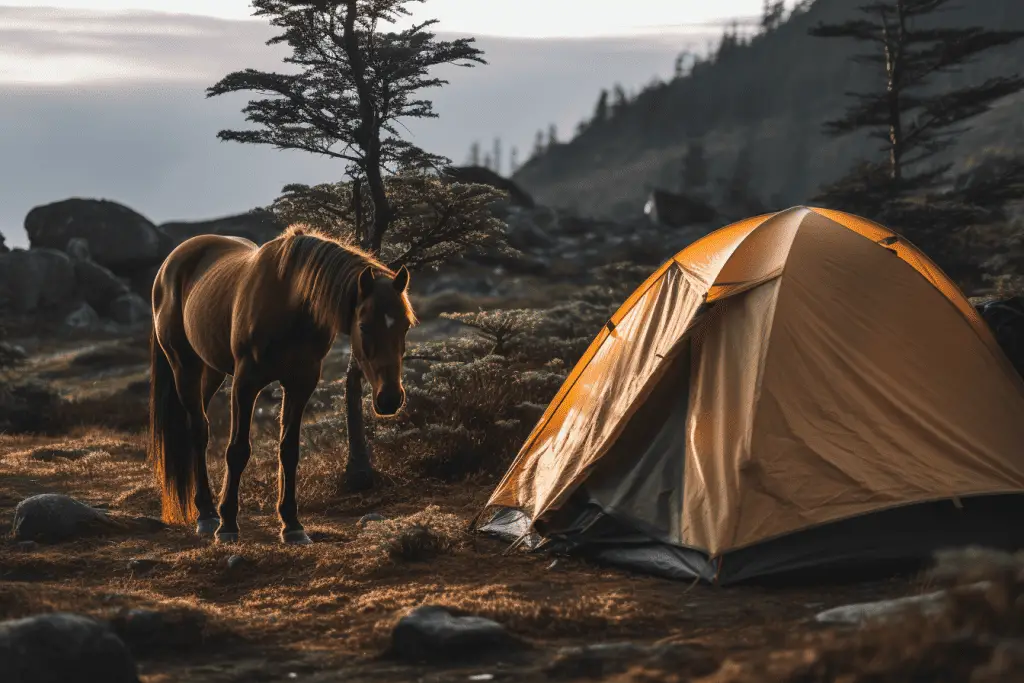
On the bright side, you’ll likely experience a deeper connection with your horse. Out there on the trail, you both have to rely on each other’s instincts and abilities. Plus, nothing builds rapport like setting up camp together in the middle of nowhere. Imagine watching the sunset from a secluded spot that only a handful of people have ever seen. These are the kinds of moments you’ll remember for a lifetime.
When it comes to honing your outdoors skills, trail camping is the ultimate test. You’ll learn to navigate, take care of your horse in a less controlled environment, and perhaps even find water or make a fire from scratch. It’s a more challenging but also a more rewarding experience that allows you to fully immerse yourself in nature.
Pros and Cons of Horseback Camping Along Trails
| Pros | Cons |
|---|---|
| Complete immersion in nature | Requires advanced planning and preparation |
| Greater sense of adventure and freedom | No amenities (e.g., no restrooms, showers) |
| Opportunity for solitude and seclusion | Higher risk (wildlife, getting lost, etc.) |
| Deepens bond with your horse | Must carry all essentials with you |
| Builds wilderness and survival skills | Terrain may be challenging |
| Less crowded than campgrounds | Weather can have a greater impact |
So there you have it. If you’re up for the challenge, horseback camping along trails offers an unparalleled sense of adventure and freedom.
Horseback Camping On Private Lands
Considering horseback camping on private land, huh? There’s a lot to love about this option. First of all, you’ll likely have the entire place to yourself, or at least share it with just a few others if you’re going with a group. This exclusivity means you can really tailor the experience to fit your interests and needs. Want to ride at dawn without disturbing other campers? Go for it. Need to set up a special corral for your horse? You’ll have the freedom to do so.
Second, there’s usually a lot more flexibility when it comes to choosing your campsite. Unlike public trails or campgrounds, which have designated camping spots, private land often gives you the liberty to pick a location that suits you best. This can make for a truly unique and personalized camping experience, right down to the view from your tent!
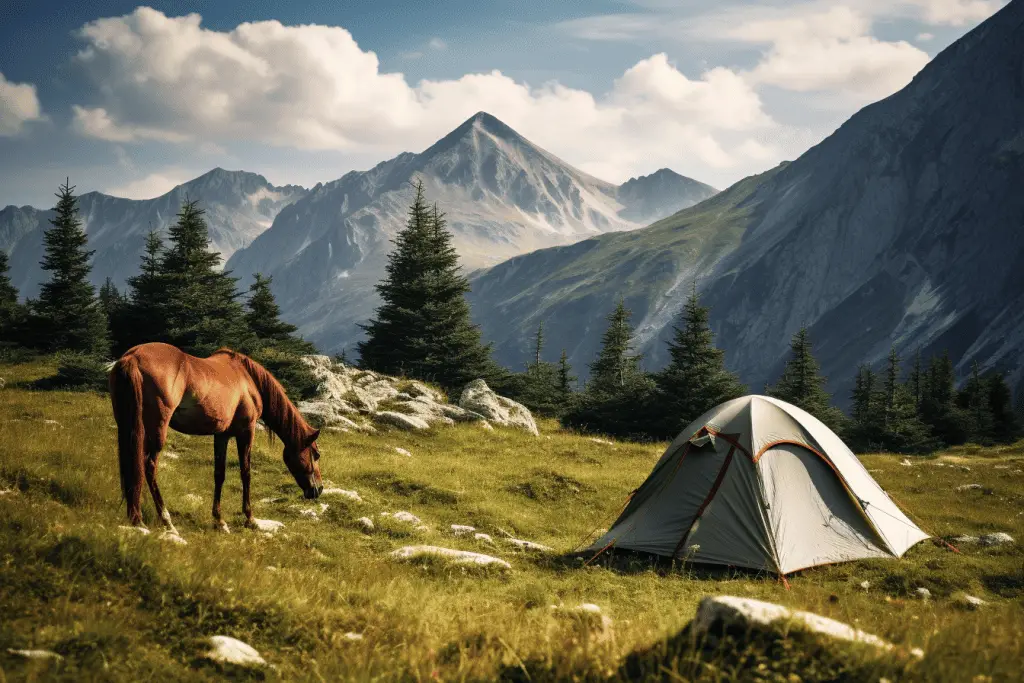
However, it’s not all just pitch your tent and ride freely; there are some responsibilities involved. You’ll need the landowner’s permission, of course, and they may have specific rules or conditions you have to follow. Some may even charge a fee for using their land. Also, remember that amenities will vary greatly; some private lands might offer basic facilities like a water source, while others may be completely undeveloped.
Last but not least, camping on private land can also offer a sense of community, albeit a more intimate one. If the land is owned by a fellow horse enthusiast, it can be a fantastic opportunity to bond and share experiences. And if you’re new to horseback camping, they might even offer some valuable tips and advice.
Pros and Cons of Horseback Camping on Private Land
| Pros | Cons |
|---|---|
| More privacy and exclusivity | Requires landowner permission |
| Flexibility in choosing camping location | May involve fees |
| Ability to tailor the experience | Amenities vary |
| Potential for a close-knit community | Landowner’s rules must be followed |
| Lower risk of encountering strangers | Limited to available terrain |
| Ideal for specialized activities or training | Liability or insurance considerations |
If you’re looking for a personalized, flexible horseback camping experience, private land could be a terrific choice! Just make sure you check all the boxes when it comes to permissions and rules.
Check out the 10 best horseback camping campgrounds in the US!
How To Go Equestrian Camping
Ready to saddle up for an epic horseback expedition? Before you hit the trails, it’s crucial to prepare not just yourself, but also your four-legged companion. Conditioning your horse involves a lot more than just a quick trot around the block. From building endurance and acclimating to gear to focusing on nutrition, your horse’s readiness is as vital as your own.
Conditioning Your Horse for the Expedition
Before you go galloping off into the sunset, let’s talk about getting your horse in tip-top shape for the adventure. Conditioning your horse isn’t just about building muscle; it’s about increasing stamina, improving coordination, and even enhancing your horse’s mental state. Just like you wouldn’t run a marathon without training, your horse needs time to adapt to the physical and mental demands of a long journey.
Basics: Introduce Terrain
- Gradually expose your horse to the types of terrain you’ll encounter (hills, water crossings, etc.).
- Observe your horse’s reactions to ensure they’re comfortable and not stressed.
Building Endurance
- Start with shorter rides and progressively increase the distance.
- Include rest days to allow for recovery and injury prevention.
- Monitor heart rate and breathing to ensure you’re not overexerting your horse.
Focus on Nutrition
- Consult your vet about dietary changes to meet increased calorie needs.
- Make sure to have plenty of fresh water available, especially after intense training.
Gear Acclimatization
- Practice with the gear you’ll use on the trip, such as a loaded saddle, to get your horse accustomed to the weight and balance.
By following these steps, you’ll ensure that your horse is physically and mentally prepared for the adventure ahead.
Equipment Checklist: What You and Your Horse Will Need
Preparing for a horseback camping trip involves more than just picking a destination. You’ll need to make sure you have all the necessary equipment for both you and your horse. Here’s a comprehensive checklist to help you out:
For Your Horse
- Saddle and Saddle Pad: Ensure they are well-fitted and comfortable for long rides.
- Bridle and Bit: Again, these should be well-fitted and suitable for your horse.
- Halter and Lead Rope: For when you’re not riding.
- Horse Boots or Wraps: To protect your horse’s legs.
- Grooming Kit: Brushes, hoof pick, etc.
- Feed and Feed Bags: Enough for the duration of your trip, plus a little extra.
- Water Containers: Collapsible buckets can be a good option.
- Horse First-Aid Kit: Including wound care items, equine medications, etc.
For the Rider
- Riding Helmet: Safety first!
- Riding Gloves: For better grip and comfort.
- Riding Boots: Choose something comfortable for long rides.
- Weather-Appropriate Clothing: Prepare for both expected and unexpected weather conditions.
- Human First-Aid Kit: Basic first-aid supplies for yourself.
- Navigation Tools: Maps, compass, and perhaps a GPS.
- Multi-Tool or Knife: Always handy to have.
- Flashlight and Extra Batteries: For those just-in-case moments.
For Camping
- Tent: Make sure it’s weather-appropriate.
- Sleeping Bag: Suited to the season and weather conditions.
- Cooking Equipment: Portable stove, utensils, and food storage.
- Water Filter or Purification Tablets: In case you need to source water.
- Insect Repellent: For both you and your horse.
- Portable Corral or Highline: For securing your horse at the campsite.
- Waste Bags: Leave no trace!
- Fire Starter: Matches, lighter, or fire-starter blocks.
Extras
- Camera: To capture the memories.
- Books or Games: For downtime.
- Snacks: For both you and your horse.
Remember, this is a general guide, so you may need to add or remove items based on your specific needs and the conditions you’ll be encountering. Make sure to double-check your list before you head out, so you’re not left in a lurch!
Rules and Guidelines: Being a Considerate Camper and Equestrian
Being a considerate camper and equestrian is crucial not only for your enjoyment but also for the well-being of the environment and others sharing the space. Here’s a guide to some important rules and guidelines:
General Camping Etiquette
- Leave No Trace: Always pack out what you pack in, including waste.
- Quiet Hours: Respect campground or trail quiet hours, usually from 10 p.m. to 6 a.m.
- Campsite Selection: Choose a site that’s at least 200 feet from lakes and streams to protect riparian areas.
- Pets: Keep pets under control, and be sure to clean up after them.
- Respect Wildlife: Observe animals from a distance and do not feed them.
Interactions with Other Campers
- Right of Way: Hikers and cyclists should yield to horses on the trail. Communicate clearly how they can best do so.
- Friendly Communication: A simple “hello” can go a long way in fostering a sense of community.
- Share the Facilities: Whether it’s a water spigot or a scenic overlook, remember that others are there to enjoy it too.
Equestrian-Specific Guidelines
- Trail Etiquette: Keep to a walk when passing others and announce your presence well in advance.
- Tethering: Use a highline or portable corral. Do not tie horses to trees as this can damage the bark and underlying tissue.
- Horse Waste: If possible, scatter manure away from camp, or pack it out if required.
- Control Your Horse: Make sure your horse is well-behaved around other people and animals.
- Equipment Check: Regularly check your horse’s equipment for fit, wear, and tear to avoid discomfort or injury.
For the Environment
- Water Protection: Use biodegradable soap and keep waste water away from natural water sources.
- Fires: Follow all fire regulations, use established fire rings or fire pans, and keep fires small.
- Plant Preservation: Do not pick plants or remove rocks; let others enjoy the natural beauty too.
Being a good steward of the land and a considerate neighbor will make the experience better for everyone involved. So, let’s all do our part to keep camping and trail riding enjoyable for years to come!
Setting Up Your Horse-Friendly Campsite
Setting up a campsite that’s comfortable for both you and your horse is essential for a successful horseback camping trip. Let’s break down how to get your campsite up and running:
Selecting the Right Spot
- Location: Choose a location that’s at least 200 feet away from water sources to protect the environment.
- Terrain: Opt for flat or slightly sloped ground. Avoid places like hills where it could be difficult for your horse to move or lie down.
- Safety: Look for any potential hazards like broken glass, holes, or branches that could pose a threat to you or your horse.
Setting Up the Human Camp
- Tent Placement: Set up your tent in an area that’s free of rocks, roots, and slope. Make sure it’s a reasonable distance from where your horse will be tethered.
- Camp Kitchen: Position your cooking area downwind from your tent to keep smells away.
- Storage: Keep food in animal-proof containers and away from the horse and tent area.
Setting Up the Horse Area
- Tethering: Use a highline or portable corral for your horse. Ensure that the area allows the horse to lie down and roll comfortably.
- Feeding: Place your horse’s feed and water buckets in a way that he can’t knock them over. Make sure water is easily accessible.
- Waste Management: Designate a spot away from your camp and water sources for manure. Some locations may require you to pack out waste.
Final Touches
- Boundaries: Create visible boundaries for your horse using ropes or portable fencing, so it’s clear where he can and can’t go.
- Emergency Gear: Keep a horse-specific first aid kit readily accessible. It’s also good to have human first-aid supplies on hand.
- Navigation: Make sure maps, compass, or GPS are easily accessible for quick reference.
Taking the time to properly set up a horse-friendly campsite will pay off in the form of a more enjoyable and safer experience. After all, a happy camper makes for a happy horse, and vice versa!
Not sold on equine camping? That’s OK, check out these other types of camping.
